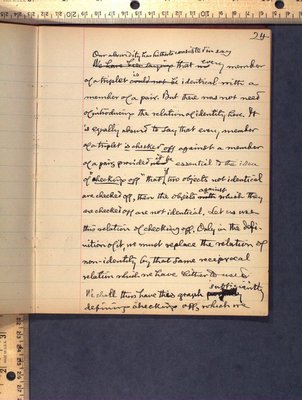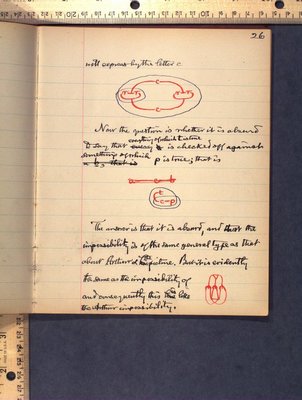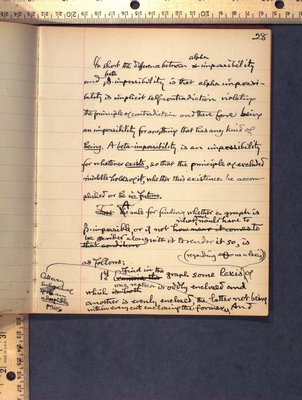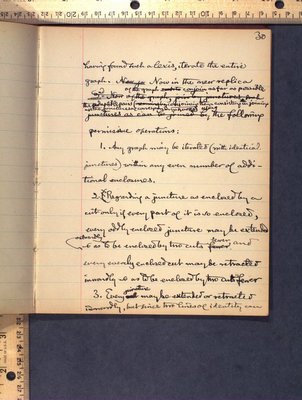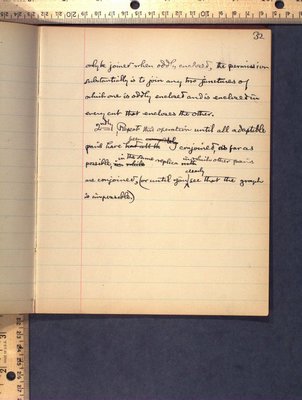Pages
14
24
Our absurdity has hitherto consisted in [say ??] that every member of a triplet is identical with a member of a pair. But there was not need of introducing the relation of identity here. It is equally absurd to say that every member of a triplet is [checked ??] off against a member of a pair, provided it be essential to the idea of "checking off" that if two objects not identical are checked off, then the objects against which they are checked off are not identical. Let us use this [relation ??] of checking off. Only in the definition of it, we must replace the relation of non-identity by that same reciprocal relation which we have hither to used. We shall [thus ??] have this graph sufficiently defining checking off, which we
15
26
will express the letter c
[encode formula or diagram in LaTeX ??]
Now the question is whether it is absurd to say that every everything of which t is true is checked off against a bsomething of which p is true; that is
[encode formula or diagram in LaTeX ??]
The answer is that it is absurd, and that the impossibility is of the same general type as that [about Arition ??] & the picture. But it is evidently the same as the possibility of [encode formula or diagram in LaTeX ??] and consequently this is like the [Aritiion ??] impossibility.
16
28
In short the difference between alpha impossibility and beta impossibilitiy is that alpha impossibility is implicit self contradiction violating the principle of contradiction and therefore being an impossibility for anything that has any kind of being. A beta-impossibility is an impossibility for whatever exists, so that the principle of excluded middle holds of it, whether this existence be accomplished or be in future.
First the A rule for finding whether a graph is B. impossible, or if not how near it comes to that condition what graph would have to be [scribed??] along with is to render it so, is as follows:
1st: Find in the graph some lexis (regarding θ as a lexis,) of which is both one replica is oddly enclosed and another is evenly enclosed, the latter not being within every cut enclosing the former. Call every such pivotal spot an adaptible pair. And
17
30
having found such a lexis, iterate the entire graph. Now in the near replica of the graph conjoin as far as possible the adaptible pairs. (meaning byconjoining [them consisting in joining [as the functionesa corresponding hooks ??]) using the following permissible operations:
1. Any graph may be iterated (with identical junctures) within any even number of additional enclosures.
2. Regarding a juncture as enclosed by a cut only if every part of it is so enclosed, every oddly enclosed juncture may be extended outwardly, so as to be enclosed by two cuts fewer, and every evenly enclosed cut may be retracted inwardly so as to be enclosed by two cuts fewer.
3. Every juncture may be extended or retracted inwardly, but since two lines of identity can
18
32
only be joined when oddly enclosed, the permission substantially is to join any two junctures of which one is oddly enclosed and is enclosed in every cut that encloses the other.
2ndly: Repeat this operation until all adaptible pairs have had all been completely conjoined, as far as possible, in the same replica in which other pairs are conjoined, (or until you clearly see that the graph is impossible.)
